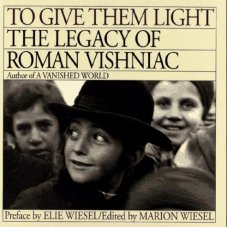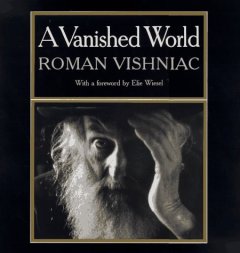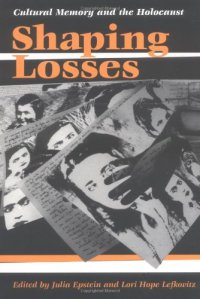 August
19
August
19
Tags
The Jewish Ghetto and Photonostalgia: Roman Vishniac’s Vanished World
 On the 19th of August 1897, one of the world’s most remarkable microbiologists and naturalist photographers, Roman Vishniac was born in Pavlovsk, the Russian Empire. Within the art world, however, he is best remembered for his photojournalistic coverage of the Eastern European Jewish ghettos prior to World War II. In the late 1930s, Vishniac was commissioned by the American Jewish Joint Distribution Committee (JDC) to photograph the Jewish poor of Eastern Europe. Out of the sixteen thousand photographs he managed to take, only two thousand survived. Most of them have been published several times in book form as Polish Jews (1947), A Vanished World (1969), and To Give Them Light (1992).
On the 19th of August 1897, one of the world’s most remarkable microbiologists and naturalist photographers, Roman Vishniac was born in Pavlovsk, the Russian Empire. Within the art world, however, he is best remembered for his photojournalistic coverage of the Eastern European Jewish ghettos prior to World War II. In the late 1930s, Vishniac was commissioned by the American Jewish Joint Distribution Committee (JDC) to photograph the Jewish poor of Eastern Europe. Out of the sixteen thousand photographs he managed to take, only two thousand survived. Most of them have been published several times in book form as Polish Jews (1947), A Vanished World (1969), and To Give Them Light (1992).
 Vishniac photographed ghetto life with superb technique and intimacy using only a twin-lens Rolleiflex, which he kept hidden beneath his coat. This unique camera style enabled him to capture the truth of documentary witness. “Vishniac’s project, as he told it, became a bold adventure, with the photographer’s pictures and his person (like his Jewish subject) at risk of seizure and arrest. He described dressing as a Nazi storm trooper and marching, camera in hand, through Berlin on Kristallnacht; impersonating a “local Jew” or a “Lithuanian salesman” to ensure his subjects’ confidence; being imprisoned in Poland and bribing guards for return of his camera and film; and developing images at a riverside under cover of night. As if to belie the danger, most images in A Vanished World do not appear surreptitious or even hurried. Forms are sharp, clear, and legible, and compositions are striking, even organized. Nevertheless, Vishniac’s claim to have taken these pictures clandestinely is part of their magic or “miraculousness,” and it underscores their aura of trespass. Concealed beneath Vishniac’s scarf or coat, the camera was apparently aimed through a buttonhole. With the shutter release cord wound down to his pocket, the Rolleiflex camera focused on infinity or, with lens extended, allowed close-ups. In what now seems an eerie mimicry of death, Vishniac would hold his breath and body still to keep images in focus.” (Julia Epstein, Lori Hope, Shaping Losses: Cultural Memory and the Holocaust)
Vishniac photographed ghetto life with superb technique and intimacy using only a twin-lens Rolleiflex, which he kept hidden beneath his coat. This unique camera style enabled him to capture the truth of documentary witness. “Vishniac’s project, as he told it, became a bold adventure, with the photographer’s pictures and his person (like his Jewish subject) at risk of seizure and arrest. He described dressing as a Nazi storm trooper and marching, camera in hand, through Berlin on Kristallnacht; impersonating a “local Jew” or a “Lithuanian salesman” to ensure his subjects’ confidence; being imprisoned in Poland and bribing guards for return of his camera and film; and developing images at a riverside under cover of night. As if to belie the danger, most images in A Vanished World do not appear surreptitious or even hurried. Forms are sharp, clear, and legible, and compositions are striking, even organized. Nevertheless, Vishniac’s claim to have taken these pictures clandestinely is part of their magic or “miraculousness,” and it underscores their aura of trespass. Concealed beneath Vishniac’s scarf or coat, the camera was apparently aimed through a buttonhole. With the shutter release cord wound down to his pocket, the Rolleiflex camera focused on infinity or, with lens extended, allowed close-ups. In what now seems an eerie mimicry of death, Vishniac would hold his breath and body still to keep images in focus.” (Julia Epstein, Lori Hope, Shaping Losses: Cultural Memory and the Holocaust)
 It seems that Vishniac’s method worked. His pictures are soulful representations of the most subtle threads of lives which were destroyed forever. Asked in an interview with Maya Benton about the images’ strong resonance among the viewers, Mara Vishniac Kohn, the photographer’s daughter, said: “Roman’s photographs actually reach the inner experience of the person looking at them. It is, I think, a hallmark of his Jewish photography, in particular, that he is able to make an emotional connection to the viewer. How precisely that happens, I can’t answer at all, but I know that it does and I know that it differs from the work of other people who have taken similar images, who do not sometimes convey this relationship – this reaching and touching almost. These photographs are able to do that. That’s part of the value and the wonder of this work.”
It seems that Vishniac’s method worked. His pictures are soulful representations of the most subtle threads of lives which were destroyed forever. Asked in an interview with Maya Benton about the images’ strong resonance among the viewers, Mara Vishniac Kohn, the photographer’s daughter, said: “Roman’s photographs actually reach the inner experience of the person looking at them. It is, I think, a hallmark of his Jewish photography, in particular, that he is able to make an emotional connection to the viewer. How precisely that happens, I can’t answer at all, but I know that it does and I know that it differs from the work of other people who have taken similar images, who do not sometimes convey this relationship – this reaching and touching almost. These photographs are able to do that. That’s part of the value and the wonder of this work.”










Thanks. One of the great achievements of the art of photography. Thom
LikeLike
Thank you Thom and welcome!
LikeLiked by 1 person
Reblogged this on http://www.seanmunger.com and commented:
ArtLark has another triumph with this article profiling photographer Roman Vishniac who captured Jewish life in the pre-Holocaust era in a way that still has profound resonance today. Truly a fascinating man and fascinating subject. You may also not know that Vishniac’s son, Wolf, was instrumental in the search for life on Mars. Some amazing stuff here!
LikeLike
A poignant record
LikeLiked by 1 person
Pingback: The Jewish Ghetto and Photonostalgia: Roman Vishniac’s Vanished World | A R T L▼R K | First Night History
Reblogged this on ACRAH.
LikeLike
Pingback: The Jewish Ghetto and Photonostalgia: Roman Vishniac’s Vanished World | A R T L▼R K | First Night History
A strong and important post. Thank you! -Jennie-
LikeLike
Great stuff, but the video link has vanished.
Regards, Pete.
LikeLike
Reblogged this on Lenora's Culture Center and Foray into History.
LikeLike